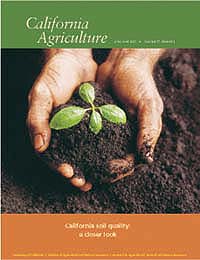All Issues
Skeptical about soil quality
Publication Information
California Agriculture 57(3):68-68.
Published July 01, 2003
PDF | Citation | Permissions
Full text
California Agriculture received several letters concerning “Looking back 60 years, California soils maintain overall chemical quality” (April-June 2003, p. 38) by F. DeClerck and M.J. Singer:
I am amazed by the conclusion that the overall chemical quality of California soils is about what it was in 1940, when there was no mention of any minerals other than phosphorus, nitrogen and carbon. Aren't calcium, gold, iron, manganese, magnesium and so forth chemicals? Or are they simply elements and not to be considered important to the “quality” of the soil?
Clayton L. Olson
Instructor/retired
Santa Cruz City Schools
The apparent increase in clay content in several groups of soils ascribed to soil erosion is inherently implausible and contradictory to changes in other soil properties, particularly total carbon and total nitrogen. A more plausible interpretation of the findings is that the authors obtained more complete dispersal of soil aggregates that were identified as silt or sand in their archival samples.
Borst George, Soil Scientist
USDA Natural Resources Conservation Service (ret.) Fallbrook, Calif.
Some hunches were borne out in the data: agriculture altered the chemistry of soils, much as expected. The conclusion of the authors once again confirmed transparently the social science aspects of agronomy: "The scientific community, as well as regulators and the general public, have recently raised concerns that uses of soil may be unsustainable … We conclude that most of the properties we have measured do not indicate a loss of soil quality in California."
I struggled to understand this conclusion even in terms of the social values I advocated and I could not. Clay percentage, clay being harder to move than phosphorus, jumped three-fold, detailing huge erosion losses, which in turn modify huge carbon gains.
Bud Hoekstra
San Andreas, Calif.
The authors respond:
Mr. Olson asks how we can make a statement about the chemical soil quality when we do not investigate all the possible elements that make up soil. Nitrogen, organic matter content, some measure of microbial activity and soil density are measures often used to assess the suitability of soil for agricultural purposes. These properties are indicators of change in the chemical, microbiological and physical properties of soil. Would our conclusions have been different had we measured many other parameters? Perhaps, but those that we measured provide a good look at some of the most important soil constituents that are likely to change the most on agricultural lands over the time period in question.
Mr. Borst suggests that the changes we measured are incompatible and that the clay data are a function of the method used to measure the clay content. All samples were treated the same in the laboratory, and we know of no reason to suggest that the archived samples would behave differently than the new samples in the particle-size analysis.
Soil quality is, as Mr. Hoekstra observes, a qualitative not quantitative parameter. We agree that the concept is qualitative, but as scientists, we try to inform the qualitative with quantitative information. The clay percentage changes may be a function of erosion, deep plowing, land-leveling or natural variability. Among the variables measured, we have the least confidence in the differences reported for the clay values. The samples were taken where landowners would give us permission based on the location of samples collected long ago. Analyses were carefully done, appropriate statistics were applied and conclusions drawn.
A more complete statistical analysis of our findings can be found in Geoderma 113(3-4):215-30.





